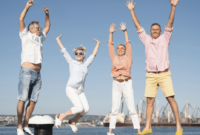South American tours for seniors offer a unique blend of adventure and relaxation, catering to the specific needs and preferences of older travelers. Imagine exploring ancient ruins, vibrant cities, and breathtaking landscapes, all while enjoying comfortable accommodations and stress-free travel arrangements. This guide delves into the diverse options available, ensuring a safe, enriching, and memorable South American experience tailored to your needs.
From carefully curated itineraries to accessible transportation and accommodations, we’ll explore everything you need to know to plan the perfect South American adventure. We’ll discuss health and safety considerations, cultural highlights, budget planning, and much more, empowering you to embark on a journey filled with wonder and discovery.
Tour Types & Destinations for Older Travelers
South America offers a wealth of experiences perfect for senior travelers, catering to various preferences and mobility levels. Choosing the right tour type is crucial for a comfortable and enjoyable journey. This section details various tour options, popular destinations, and accessibility considerations to help you plan your ideal South American adventure.
Tour Types Suitable for Seniors
Several tour types are designed with the needs and preferences of older travelers in mind. Cruises provide a convenient and relaxing way to explore multiple destinations without the hassle of frequent packing and unpacking. Land tours offer more in-depth exploration of specific regions, often including smaller towns and villages inaccessible by cruise ship. Small group adventures provide a more personalized experience with a smaller group size, allowing for more interaction with the guides and fellow travelers, and often incorporating a slower pace.
Popular Destinations for Senior Travelers in South America
Many South American destinations are particularly well-suited for senior travelers. The charming colonial cities of Cusco, Peru, and Cartagena, Colombia, offer a rich history and culture, with manageable walking distances and plenty of opportunities to rest. The breathtaking landscapes of Patagonia in Chile and Argentina offer stunning scenery, often accessible by comfortable vehicles and with options for gentler hikes and scenic drives. Buenos Aires, Argentina, is renowned for its vibrant culture, tango shows, and sophisticated restaurants, making it a perfect destination for a more leisurely pace. The Galapagos Islands, while requiring a bit more physical exertion, offer unparalleled wildlife viewing experiences with well-equipped cruise options that cater to different mobility levels.
Accessibility Features of South American Tours
Accessibility varies significantly depending on the tour type and operator. Cruises generally offer better accessibility than land tours, with elevators, ramps, and accessible cabins. Land tours may have limited accessibility, particularly in more remote areas. However, many reputable tour operators now offer tours specifically designed for seniors with reduced mobility, featuring slower paces, shorter distances, and accessible transportation. Inquire about specific accessibility features when booking your tour, such as the availability of ramps, elevators, accessible restrooms, and assistance with luggage. Some operators even provide specialized equipment like wheelchairs or walkers upon request.
Tour Options Comparison Table
| Tour Type | Destination | Accessibility Features | Price Range |
|---|---|---|---|
| Luxury Cruise | Galapagos Islands | Accessible cabins, elevators, ramps, assistance with excursions | $$$ |
| Small Group Land Tour | Cusco & Machu Picchu | Modified itineraries for reduced mobility, accessible transportation options available (may require pre-arrangement) | $$ |
| Guided City Tour (Buenos Aires) | Buenos Aires | Accessible transportation (buses with ramps), shorter walking distances, optional wheelchair rentals | $ |
| Patagonia Scenic Drive | Patagonia (Chile/Argentina) | Comfortable vehicles, limited walking, scenic viewpoints with minimal effort | $$ |
Health & Safety Considerations
Planning a South American adventure requires careful consideration of health and safety, especially for senior travelers. This section details crucial aspects to ensure a smooth and enjoyable trip, minimizing potential risks and maximizing the experience. Understanding the nuances of healthcare access, necessary vaccinations, and appropriate insurance is paramount for peace of mind.
Health Precautions and Vaccinations
Before embarking on your South American journey, consulting your physician is crucial. They can provide personalized advice based on your individual health history and planned itinerary. Recommended vaccinations often include those for Hepatitis A and B, typhoid, yellow fever (depending on the specific regions visited), and influenza. Additionally, staying up-to-date on routine vaccinations like tetanus and diphtheria is vital. Your doctor will also discuss necessary precautions against altitude sickness, particularly if you plan to visit the Andes. They may recommend medication to help mitigate potential symptoms. Remember to bring copies of your vaccination records and any prescription medications you take, along with a list of your allergies.
Travel Insurance for Seniors
Securing comprehensive travel insurance is non-negotiable for senior travelers. Standard policies often have limitations, particularly regarding medical emergencies and pre-existing conditions. Therefore, it’s essential to find a plan specifically designed for older adults. These policies typically offer broader coverage, including medical evacuation, repatriation, and extended hospital stays. Compare policies from different providers to ensure you select one that meets your specific needs and budget, considering factors such as the length of your trip and the activities you’ll be undertaking. Look for policies with 24/7 emergency assistance services.
Emergency Medical Services and Healthcare Accessibility
The accessibility and quality of emergency medical services vary significantly across South America. Major cities generally have better-equipped hospitals and readily available ambulances, while more remote areas may have limited resources. Understanding these regional differences is crucial for planning. In urban areas, you’ll likely find hospitals with English-speaking staff, though this is less common in rural settings. Consider carrying a comprehensive first-aid kit and familiarizing yourself with local emergency numbers. Researching the healthcare infrastructure in your chosen destinations beforehand is highly recommended. For example, while major cities like Buenos Aires and Santiago offer advanced medical care, access might be more challenging in the Amazon rainforest or the Andes mountains.
Recommendations for Maintaining Health and Safety
Prioritizing health and safety during your trip is essential. Here are some recommendations:
- Consult your doctor before traveling and obtain necessary vaccinations and medications.
- Pack a comprehensive first-aid kit including any personal medications.
- Stay hydrated by drinking bottled water and avoiding tap water.
- Be mindful of food safety and avoid consuming raw or undercooked food.
- Use insect repellent to protect against mosquito-borne illnesses.
- Take necessary precautions against sun exposure, such as wearing sunscreen and a hat.
- Be aware of your surroundings and take precautions against petty theft.
- Inform someone of your itinerary and check in regularly.
- Carry a copy of your passport, travel insurance information, and emergency contact details.
- Learn basic Spanish phrases to facilitate communication.
Cultural & Historical Aspects
South America offers a rich tapestry of cultural experiences and historical sites, perfectly suited to the interests and physical capabilities of senior travelers. From the ancient ruins of the Inca to the vibrant colonial architecture of cities like Cartagena, the continent provides a captivating journey through time and diverse cultures. Careful planning, however, ensures a comfortable and enriching experience for older adults.
Exploring these historical and cultural wonders needn’t be strenuous. Many sites offer accessible routes and transportation options, and the pace of exploration can be adjusted to individual needs. Furthermore, the warmth and hospitality of the South American people add another layer to the overall experience, making it a truly memorable journey for seniors.
Ancient Civilizations and Archaeological Sites
South America is home to some of the world’s most impressive ancient civilizations. The Inca Empire, for instance, left behind breathtaking ruins like Machu Picchu in Peru, a site that offers a glimpse into their sophisticated engineering and spiritual beliefs. While reaching Machu Picchu can require some physical exertion, there are options for seniors, including train journeys that reduce walking distances and the use of porter services. Other sites, such as the Nazca Lines in Peru (best viewed from a plane to avoid strenuous activity) and the Tiwanaku ruins in Bolivia, offer fascinating insights into pre-Columbian cultures with minimal physical demands. These sites are significant for their intricate architecture, sophisticated astronomical knowledge, and the enduring mysteries surrounding their construction and decline.
Colonial Cities and Architecture
Many South American cities boast stunning colonial architecture, reflecting centuries of European influence blended with indigenous styles. Cities like Cartagena in Colombia, with its colourful buildings and cobblestone streets, offer a captivating journey through time. Exploring these cities can be done at a leisurely pace, allowing ample time to appreciate the details of the architecture, visit museums, and enjoy the local atmosphere. These cities provide opportunities for gentle strolls, enjoying the vibrant street life and delicious cuisine. For example, a relaxing horse-drawn carriage ride through Cartagena’s historic center provides a unique perspective and minimal physical exertion.
Low-Impact Activities for Seniors
A variety of low-impact activities cater to different physical abilities. These activities allow seniors to engage with the culture and history of South America without undue strain.
- Museum visits: Many museums throughout South America showcase pre-Columbian artifacts, colonial art, and other cultural treasures. These offer a comfortable and enriching experience with minimal physical activity.
- Guided walking tours: Opt for shorter, slower-paced walking tours that focus on specific areas or themes. Many tour operators cater specifically to the needs of seniors.
- Boat trips: Enjoy scenic boat trips along rivers or coastal areas. This provides a relaxing way to see the landscape and potentially spot wildlife.
- Cooking classes: Participate in hands-on cooking classes to learn about local cuisine and culinary traditions. This is a fun and engaging activity with minimal physical demands.
Recommended Cultural Experiences for Older Travelers
Planning for a fulfilling and comfortable trip is key for senior travelers. The following cultural experiences are carefully chosen for their accessibility and enriching nature:
- Witnessing a traditional dance performance in Argentina or Chile.
- Exploring the vibrant markets of Lima, Peru, or La Paz, Bolivia (focus on specific areas to avoid overexertion).
- Visiting a local coffee or wine plantation for a tasting and tour.
- Attending a tango show in Buenos Aires, Argentina (choose a venue with comfortable seating).
- Taking a leisurely train journey through the Andes Mountains.
Visual Representation of a Sample Itinerary
This section details a sample 10-day South American tour itinerary specifically designed for senior travelers, prioritizing comfort, accessibility, and enriching cultural experiences. The itinerary focuses on manageable daily activities and incorporates ample time for relaxation and personal exploration. The visual representation described below would serve as a helpful overview for potential travelers.
Itinerary Overview
This 10-day itinerary balances exploration with relaxation, focusing on Peru and its diverse landscapes. It prioritizes comfortable accommodations and accessible transportation options.
Daily Itinerary Breakdown
The visual representation would be a calendar-style graphic. Each day would be represented by a box, containing the location (e.g., Cusco, Sacred Valley), a small icon representing the primary activity (e.g., a temple for Machu Picchu, a mountain for the Andes), and a brief description (e.g., “Explore Machu Picchu,” “Relaxing afternoon in the Sacred Valley”).
Day 1: Arrival in Cusco & Acclimatization – Arrive at Alejandro Velasco Astete International Airport (CUZ) in Cusco. Transfer to a comfortable hotel in the city center, ideally within walking distance of major attractions. The hotel would offer amenities catering to seniors, such as elevators and accessible rooms. The afternoon would be dedicated to rest and acclimatization to the altitude. A gentle walk around the Plaza de Armas is suggested.
Day 2: Cusco City Tour – A guided tour of Cusco’s historical center, focusing on accessible routes and pace. This includes visits to the Plaza de Armas, Qorikancha (Temple of the Sun), and Sacsayhuamán (a significant Inca fortress with paved paths and manageable inclines). Transportation would be via a comfortable, air-conditioned coach.
Day 3: Sacred Valley Exploration – A day trip to the Sacred Valley, visiting Ollantaytambo (an impressive Inca town with accessible areas) and Pisac (known for its market and Inca ruins, with options for avoiding strenuous climbs). Lunch would be at a restaurant with accessible facilities. Transportation would be a comfortable private van.
Day 4: Train to Aguas Calientes & Machu Picchu Town – A scenic train journey to Aguas Calientes, the town at the base of Machu Picchu. The train offers comfortable seating and accessible boarding. Check into a hotel with accessible rooms in Aguas Calientes. A relaxed evening exploring the town is suggested.
Day 5: Machu Picchu Exploration – Guided tour of Machu Picchu, utilizing accessible routes and a pace suitable for seniors. Options for bus transport to the entrance or a more gradual, paved path are available. The tour would highlight key sites while minimizing strenuous activities.
Day 6: Return to Cusco & Relaxation – Train journey back to Ollantaytambo, followed by a comfortable transfer to Cusco. The afternoon is free for rest and relaxation at the hotel or gentle exploration of Cusco at one’s own pace.
Day 7: Cusco – Optional Activities – A day for optional activities, such as visiting a local market, enjoying a traditional Peruvian cooking class (with modifications for mobility), or simply relaxing and enjoying the city’s atmosphere. Accessible transportation options would be readily available.
Day 8: Free Day/Optional Excursion – A free day to explore Cusco independently or join an optional excursion to a nearby location like the Moray agricultural terraces (with accessible viewing points).
Day 9: Departure Preparations – Morning at leisure for last-minute souvenir shopping or relaxation. Afternoon transfer to the airport for departure.
Day 10: Departure from Cusco – Departure from Cusco.
Accommodation & Transportation
Accommodation throughout the tour would be in comfortable, 3-4 star hotels with accessible rooms and amenities. Transportation would primarily involve comfortable, air-conditioned coaches for longer distances and private vans for shorter trips. Train travel would be utilized for the journey to and from Machu Picchu, with priority given to comfortable, accessible train cars.
Final Wrap-Up
Planning a South American tour for seniors doesn’t have to be daunting. With careful consideration of your needs and preferences, you can create a truly unforgettable experience. By focusing on accessibility, comfort, and engaging cultural immersion, you can enjoy the richness of South America while prioritizing your well-being. Embrace the adventure and create memories that will last a lifetime.




